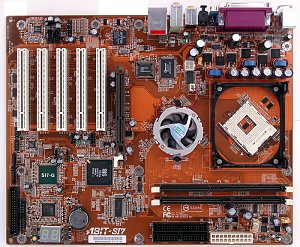ABIT SI7-G
(SiS R658) Mainboard
|
ABIT's line of SiS R658 based boards includes
two models. We tested the top one equipped with a 1Gbit network controller instead
of a 100Mbit one of SI7. We got a production sample but it came only with a CD
with press-releases and specification of the latest models. 
Multiple connections and controllers typical of any modern top-of-the-line
solution make assembling a bit complicated: SATA RAID and FDD connectors are too
close to the edge, and audio-ins are in front of PCI slots. It's not easy to handle
memory modules because of numerous connectors there. It's not difficult to reach
the only jumper when the board is already installed. Its functions are shown on
the textolite. 3-channel switching voltage regulator incorporates 6 capacitors
of 3300 uF and 4 of 1200 uF. Integrated controllers: -
audio controller based on the chipset and Avance Logic ALC650 AC'97 codec; 5.1
audio system supported, front audio inputs/outputs and SPDIF connectors provided;
-
Broadcom BCM5702WKFB based network controller; 10BaseT/100BaseTX/1000BaseT supported
(Gigabit Ethernet);
- SATA RAID controller based on Silicon Image
Sil3112144ACT chip with RAID 0, 1 supported through SATA150 protocol
-
FireWire bus controller based on the chipset.
The board features
a POST controller which provides information on two 7-segment LEDs, reset button,
power button, Forward and Back buttons (previous/next Post controller code). Power
on, +5 V in StandBy mode and transition to the next/previous POST controller code
are indicated with the LEDs. Non-unsoldered connectors: none. System
monitoring is supported by Winbond W83697HF chip. It controls:
- processor, memory voltages, +3.3, +5 and +12 V, VBAT and VDDQ;
-
speed of 2 fans;
- temperatures of the processor (built-in sensor)
and the board (built-in sensor).
There are 2 connectors for adjustable
and 2 for unadjustable connection of fans (one of them is connected to a fan on
the north bridge's heatsink). Brief board's characteristics: memory
slots - 2 32bit RDRAM; expansion slots - AGP/ 5 PCI; I/O ports - 2 COM/ LPT/ 2
PS/2/ 6 USB 2.0 / 2 FireWire; dimensions - 305x245 mm.

Settings:
| with jumpers and switches |
Jumper to clear up the CMOS |
|
| BIOS based on AMI v3.31a |
Setup of memory timings |
+ |
Rambus TDSEL Turbo Mode, Rambus RDSEL Turbo Mode, Back-To-Back
Read, RAS-to-CAS Delay, Row Precharge Time, RAS Asserted Time |
| Setup of memory frequency |
+ |
DRAM (FSB 100) = 450, 600, 800 and 1066 MHz; DRAM (FSB 133) =
599, 798, 1064 and 1419 MHz; Special Mode: FSB/DRAM = 100/1200, 100/1333, 133/1200,
133/1333 MHz |
| Setup of AGP bus |
- |
|
| Setup of PCI bus |
- |
|
| Changeable scaler of AGP and PCI buses |
+ |
AGP(PCIx2) = 2/3 FSB, 1/2 FSB, 67, 75, 86 MHz |
| Manual assignment of interrupts |
+ |
|
| Changeable FSB frequency |
+ |
100-250 MHz in 1MHz steps |
| Changeable CPU multiplier |
+ |
x8-x32 |
| Changeable core voltage |
+ |
1.1-1.85 V in 0.025V steps |
| Changeable memory voltage |
+ |
2.5, 2.6, 2.7, 2.8 V |
| Changeable chipset voltage |
- |
|
| Changeable AGP bus voltage |
+ |
1.5, 1.6, 1.7, 1.8 V |
We used the BIOS 10 as the latest available version.
I don't think this is a promising solution as its price doesn't match its performance.
Although expandability and a wide range of settings look attractive, the chipset
lets the board down. That is why it could be interesting for lovers of new technologies.
Test results:
Write a comment below. No registration needed!
|
|

